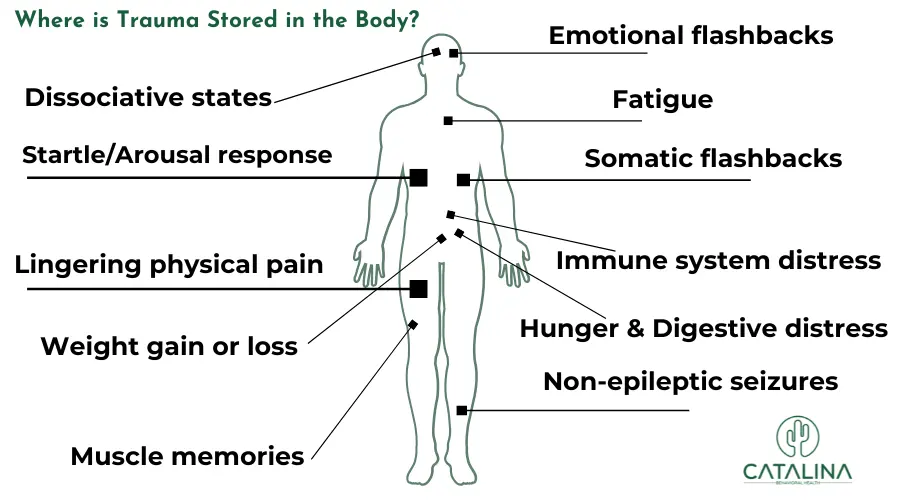Get Insights on Trauma in the Body and a Path to Healing at Catalina
You’ve probably heard that trauma is stored in the body. Additionally, you may know that trauma can affect your physical health just as much as it impacts you emotionally or psychologically.
The question, then, is: Where is trauma stored in the body?
Our life experiences can affect the body and the brain deeply, even if we try to ignore or forget them. However, moving forward is possible. Getting informed on the effects of trauma and trauma healing can be incredibly valuable, leading to the opportunity to seek emotional support and reach a significantly improved quality of life.
This article will go over where trauma is stored in the body first. Then, we’ll talk about the fundamental ability the brain has to heal, techniques for releasing trauma, and how treatment can help.
Confidential Trauma and PTSD Assessment – Call Now!
Where Trauma is Stored in the Body: Chart and Explanation
Many people who have survived traumatic experiences face chronic stress. When you are in a state of chronic stress, you will likely notice physical and psychological trauma symptoms.
It can be hard to link the symptoms you’re going through in the present moment back to the past–you might wonder, ”Why would past trauma affect me right now?”
Trauma can affect the entire body. There’s more than one way to interpret where in the body trauma is stored, depending on what that means to you. Here’s an explanation of where and how past trauma is remembered by the body.
Trauma and the Brain
The mind-body connection is very real. Rather than the body itself, trauma is stored in the brain’s emotional memory centers. Specifically, the hippocampus and amygdala.
Found deep in the temporal lobe, your hippocampus consolidates short-term memories into long-term memories. It also influences decision-making. People with more severe post-traumatic stress disorder (PTSD) symptoms are more likely to have abnormalities in the hippocampus. That said, it may be noteworthy to say that trauma is linked to problems with memory processing, as well as trouble making decisions.
Your amygdala is located in the temporal lobe, just above the hippocampus. Playing a key role in emotional responses like anxiety, anger, and fear, the amygdala processes external input, links it with knowledge from the past, and creates a response or reaction. With trauma responses–which can be physical and psychological–in mind, this makes sense.
Physical Effects of Trauma and Trapped Emotions

Unaddressed trauma can lead to a range of physical health effects. Sometimes, this is what people mean when they say, “The body keeps the score” or “Trauma is stored in the body.”
Common physical symptoms linked to trauma and PTSD include but aren’t limited to:
- Distress in the digestive system (e.g., abdominal pain, reflux)
- Sleep disturbance (e.g., insomnia)
- Tight jaw muscles or teeth grinding
- Body aches
- Muscle tension
- Headaches
When faced with traumatic memories or emotional distress, you might notice that you have a physical response or bodily sensations. For example, an increased heart rate, fluttering in the stomach, or body temperature changes.
Trauma can increase the risk of some chronic or long-term physical ailments, like high blood pressure, heart disease, TMJ disorder, and chronic pain conditions.
Get Accredited Treatment Programs at Catalina
The Nervous System
The role of the nervous system is to send messages from the brain to the body and vice versa.
As for the parts of the body it relates to, the nervous system is a complex, intricate network that involves your brain, spinal cord, and nerves. Trauma can cause nervous system dysregulation, which can lead to physical, emotional, and cognitive symptoms of PTSD. For example, hypervigilance.
The nervous system controls the fight-or-flight response. Although this response is meant to protect you in times of danger, trauma survivors often have an overactive fight-or-flight response, leading to an influx of stress hormones.
The Brain’s Natural Recovery Process
Although trauma can change the body and the brain, healing can, too. When you get treatment for trauma and mental health disorders like PTSD, the brain may change, and your nervous system may become more regulated.
Techniques for Releasing Stored Trauma

Seeking professional treatment is the best way to promote emotional healing and recovery from some of the possible effects of trauma.
Trauma-Informed Therapy Methods
It is highly recommended that those who have experienced trauma participate in therapy. Therapeutic approaches that can help trauma survivors include but aren’t limited to the following.
- Trauma-focused cognitive behavioral therapy
- Somatic experiencing
- Cognitive processing therapy
- Eye movement desensitization and reprocessing (EMDR)
- Prolonged exposure
- Narrative exposure therapy
Other therapies, like dialectical behavior therapy, can support trauma recovery by teaching you coping skills, healthy relationship skills, and distress tolerance. In addition to therapy, some types of medication can be helpful for those with trauma disorders. For example, antidepressant medications.
Self-Care and Relaxation Techniques
Basic self-care is important, but it can be easy to overlook. Trauma survivors can support themselves by ensuring that they get enough sleep (or work toward getting enough sleep as a goal, with the help of medical and mental health providers), practice stress management, eat regularly, and get appropriate physical activity.
Trauma-informed yoga, progressive muscle relaxation, and breathing exercises can help trauma survivors. Techniques like self-massages that relieve tension in the neck may be of help when trauma triggers manifest physically through pain or tightness.
How Treatment Helps Trauma Survivors Release Stored Trauma

In the trauma treatment program at Catalina Behavioral Health, multiple types of trauma therapy and supportive treatments are combined to help you find whole-person relief. We help trauma survivors, including those with PTSD, complex PTSD, and related mental health conditions, heal and discover healthy ways to cope with high-stress times and trauma triggers.
Our comprehensive approach involves groups, individual therapy sessions, mind-body therapies, and other treatments. For example, creative therapies to promote self-expression, family therapy, physical activity, nutrition support, and medication management for those who find it beneficial.
All clients attending Catalina Behavioral Health for trauma recovery will get a personalized treatment plan. Your treatment plan with us will target your specific needs while outlining what your treatment schedule will look like.
Types of Trauma Treatment Programs
Inpatient and outpatient trauma treatment programs are available at Catalina Behavioral Health.
Whether you need daily therapy and around-the-clock supervision or have to balance trauma therapy with work or school, we have a program that can help.
When you reach out to us about getting help for trauma at our treatment center in Arizona, we’ll schedule an intake assessment and help you find the right starting level of care.
If you experience substance abuse–which is significantly more common among trauma survivors—we offer dual-diagnosis treatment programs that can help.
Call Catalina for PTSD, CPTSD, and Trauma Treatment
People tend not to understand quite how severe the effects of trauma are until they start to overcome them.
Our trauma treatment programs in Arizona are here to help you or your loved one heal from the chronic stress caused by past trauma. Reaching out for help can be tough, but it is 100% worth it.
Please call Catalina Behavioral Health today to learn more about our trauma treatment programs, verify your health insurance coverage, or for help with any questions you might have. You are welcome to contact us for yourself or someone else you know.
Up To 100% of Rehab Costs Covered By Insurance
FAQs Regarding Trauma and the Body
How do you know where trauma is stored in your body?
Even though trauma is remembered by the brain, it can manifest physically. A body scan can help you notice any physical pain or related symptoms you are experiencing.
Close your eyes and take note of how each part of your body feels, starting with your head and moving down to your toes. Do you notice headaches? What about jaw tension, facial pain, or tooth pain? How about tension in the neck or back?
While it is not that the body parts themselves are holding trauma, unresolved feelings and triggers related to past traumas can cause pain, tension, and other negative health effects, which can be anywhere from mild to severe.
Body-based approaches for trauma, like somatic experiencing, may be helpful if this is something you notice.
How to release emotional trauma from the body?

Therapies like TF-CBT, EMDR, and somatic experiencing can help trauma survivors with emotional healing. When you work with a therapist, you can release trapped emotions in a safe environment, increase body awareness, and learn skills that help you during times of increased stress or trauma triggers.
Getting help for unresolved trauma may also alleviate physical reactions or symptoms.
How can you unpack trauma?
Therapy can help you unpack the implications of traumatic events, like repressed emotions and painful memories. It is possible to heal from trauma, whether you’ve been through a singular traumatic event, prolonged trauma, or multiple traumatic experiences.
References
- https://www.ncbi.nlm.nih.gov/books/NBK482171/#:~:text=The%20 hippocampus%20is%20the%20%22 flash,hippocampus%20 proper%2C%20and%20the%20 subiculum.
- https://www.ncbi.nlm.nih.gov/books/NBK537102/#:~:text=The%20 amygdala%20is%20an%20 almond,of%20the%20uncus.%5B1%5D
- https://pmc.ncbi.nlm.nih.gov/articles/PMC3181836/
- https://www.apa.org/ptsd-guideline/treatments





